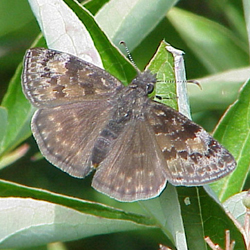Find a Butterfly
Dreamy Duskywing
Erynnis icelus
Named
Scudder and Burgess, 1870

Identification
Wingspan: 9/10-1 1/4 inches. A common, small, dark and relatively distinctive member of this confusing genus. In addition to its small size, icelus can be recognized by the pronounced ashy gray dusting and lack of transparent spots on the forewing above. The vertical bands that run across the outer forewing above tend to be more broken and dot-like than those of its close relative the Sleepy Dusky Wing. Viewed from above the labial palpi project forward more prominently than in Sleepy.
Distribution
Occurs continent-wide from the Northwest Territories and California south in the mountains to northern Mexico. It skirts the Great Plains to the north reaching Nova Scotia in the east and ranging south in the Appalachians to northern Georgia. The species occurs throughout New England in appropriate habitat.
Status in Massachusetts
Common to uncommon throughout the state; less frequent eastward. For Nantucket, Kimball and Jones (1943) note only two recent records, but characterize the species as "not rare" on Martha‘s Vineyard. Tends to be commonest in open successional habitats and wetland edges where its food plants thrive. Maximum: 20, 28 May 1988, Raynham (Bristol Co.).

Flight Period in Massachusetts
An early species (though usually the last duskywing to appear), icelus is typically on the wing beginning in mid May and flying until mid- to late June. Extreme dates: 10 May "near Boston", (Scudder, 1889); 12 May 1988 at Newton (Middlesex Co.), C. Arbogast; 20 June 1987 at Amherst (Hampshire Co.), R. Miller. Kimball and Jones (1943) erroneously state that the species is double brooded on Martha‘s Vineyard with the second brood flying "from mid-June into July".
Larval Food Plants
Chiefly willows and poplars/aspens, including Heart-leaved Willow (Salix cordata), Quaking Aspen (Populus tremuloides), Bigtooth Aspen (P. granidentata), Balsam Poplar (P. balsamifera) and Lombardy Poplar* (P. nigra) plus Black Locust* (Robinia pseudoacacia).
Adult Food sources
Found nectaring on eight species of flowering plants by Atlas workers including cherry, dewberry, clover, vetch, geranium, dogwood, blueberry, and hawkweed. Males have been seen "puddling".

Habitat
Open woods, roadsides, stream margins, wetland edges and other areas where the tree species preferred by its caterpillar occur.
Life Cycle
EGG: Very pale green and dome shaped with 10-14 prominent vertical ribs and finer raised lateral lines in between; microsculpture of tiny raised points. OVIPOSITION: According to Scudder (1889): "The eggs are laid singly on the upper surface of leaves, the younger, but not the youngest leaves being selected for the purpose, and ordinarily at a height of not more than about three to four feet from the ground." LARVA: Fat bodied, widest near the middle and tapering to both ends. Overall color gray-green, yellower above with a dark line down the back and a pale line along the sides; covered with fine hairs. Head reddish brown. The caterpillar constructs a leaf roll loosely "sewn" together with silk, but closed and secured more tightly when molting; following the molt it makes a new shelter from a fresh leaf. It feeds only on its "home leaf" and only at night, when it leaves the rolled section. CHRYSALIS: Relatively long and cylindrical, smooth and covered with "fine short down" (Scudder, 1889); head and wing areas brown to reddish brown; wing cases with a greenish tinge; abdomen pale flesh color PUPATION: Within the larval hibernaculum lined with silk; the caterpillar pupates in early spring without further eating; duration: 16-21 days. OVERWINTERING STAGE: Mature larva.
Notes
Several authors note that icelus (in Scudder‘s words) "is not so vigorous" as other duskywings and is therefore relatively easy to capture. Scudder also notes that "A specimen in the Museum of Comparative Zoology has both its eyes ornamented with the pollonia of an orchid", raising the possibility that this species may be instrumental in the pollination of one or more spring-blooming orchids.
Account Author
Chris Leahy



